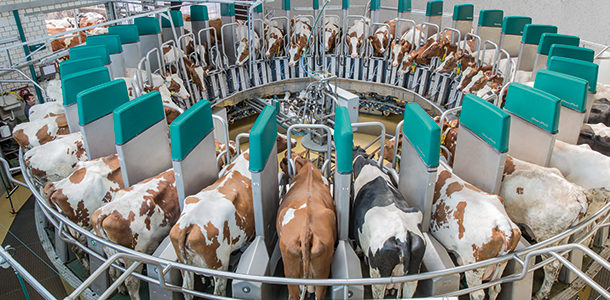This article was #5 of the Top 25 most well-read articles on www.progressivedairy.com in 2014. It was published in the Sept. 4, 2014 Extra e-newsletter, then Oct. 1, 2014 print issue. On Aug. 20, a special groundbreaking event was held for the construction of North America’s first installation of an automatic rotary parlor. The 72-stall rotary parlor being built at Mlsna East Town Dairy in Cashton, Wisconsin, will also be the largest robotic milking system in place worldwide, states Matt Daley, president and CEO of GEA Farm Technologies North America.
Project update: During the final planning stages of this project, the dairy re-evaluated whether or not the 72-stall automatic rotary parlor would be able to fulfill its needs and ultimately decided to pursue another option. “They could not guarantee the number of cows per hour,” Nick Mlsna says.
Still wanting to utilize as much automation as possible, the farm is now planning to install an 80-cow rotary parlor equipped with a teat prepping device and automated post-dipping and backflush system. This will eliminate the labor demand for a post-dipper in the parlor.
—Progressive Dairyman Editor Karen Lee
Click here to read more about why the project was halted.
:
On Aug. 20, a special groundbreaking event was held for the construction of North America’s first installation of an automatic rotary parlor. The 72-stall rotary parlor being built at Mlsna East Town Dairy in Cashton, Wisconsin, will also be the largest robotic milking system in place worldwide, states Matt Daley, president and CEO of GEA Farm Technologies North America.
A revolutionary breakthrough for the North American dairy industry, dairy owner Nick Mlsna simply views it as a logical next step for his farm. “We needed a new parlor,” he says, noting the farm’s existing double-12 parallel parlor was built in 1997.
The family farm, owned and operated by Nick and LeAnne Mlsna and Nick’s parents, Dennis and Barbara Mlsna, currently milks 900 Holstein cows, which are housed in four naturally ventilated, sand-bedded freestall barns. The cows are milked three times a day, which requires three people working eight-hour shifts.
In addition to the new parlor, the family plans to build a 1,300-cow, cross-ventilated, sand-bedded barn and grow its herd size to 2,000 milking cows.
“I didn’t want to build a new parlor without expanding the dairy,” Mlsna says.

By utilizing automation, Mlsna is able to more than double his herd size and continue to milk the herd three times a day without increasing the farm’s current labor force of 21 employees.
He admits he has been lucky with hiring workers for his dairy, recognizing good employees are in tight supply and that he is unsure about having a strong labor force to draw from in the future.
Once the parlor is up and running, Mlsna anticipates he will need one employee in the parlor to oversee the milking process, along with someone moving cows to the parlor. The rest of the farm’s labor will be shifted to other tasks. He hopes to place more emphasis on the fresh cow area and calf raising. The farm is also building a new calf barn with automatic feeders, no longer having calves raised off the farm.

In addition to labor concerns, Mlsna says he opted for the automation because of “the consistency it provides for the cows and to take advantage of the advanced technology.”
In order to see this particular parlor firsthand, Mlsna traveled in December to Europe, where there have been two installations of the DairyProQ rotary by GEA Farm Technologies thus far. “I was impressed by the volume of cows it could handle and its ability to milk each cow with consistency,” he says.
Each stall unit on the rotary is equipped with its own robotic arm. Teat cup attachment, teat prep (including pre-dipping), fore stripping, stimulation, the milk harvest process and post-dipping are done in-liner, in one single attachment. It is the same process on every cow at every milking, every day.
The unit is automatically removed and backflushed between milkings to sanitize the clusters between cows.
A semi-automatic or manual mode can be selected for problem or special-needs cows that need extra attention in the parlor.

After four years in development, the parlor manufacturer says it offers an automatic rotary parlor with more capacity and more functions in one unit, resulting in a more commercial and more serviceable system than other automatic rotary parlors in existence.
“It is an achievement that all can be proud of to revolutionize milk production in such a manner,” Daley says. “The scale is extraordinarily large, but we have confidence that we are ready at this stage.”
The new parlor at Mlsna East Town Dairy is expected to be complete in March 2015. At that time, Mlsna plans to start it up with his existing herd and hopefully grow the dairy with 200 cows each month until he reaches capacity. PD
PHOTOS
PHOTO ONE: A fully automated rotary milking parlor will allow the Mlsna family to more than double its herd size without increasing labor.
PHOTO TWO: Special guests gathered for a groundbreaking event at the construction site of North America’s first automatic rotary parlor in Cashton, Wisconsin.
PHOTO THREE: This stretch of land at Mlsna East Town Dairy will be the location of a new 72-cow rotary parlor and 1,300-cow cross-ventilated barn.
PHOTO FOUR: Teat cup attachment, teat prep (including pre-dipping), fore stripping, stimulation, the milk harvest process and post-dipping are done in-liner, in one single attachment. Photos provided by GEA Farm Technologies.




